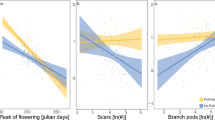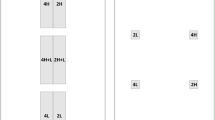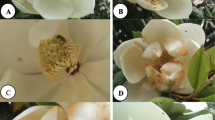Abstract
Understanding the inter-play plant–pollinator is essential to develop ecosystem services of faba bean and improved populations for low-input systems. We analyzed the phenotypic selection exerted by pollinators on floral traits involved in the plant pollinator inter-play. We test whether variation in pollinator-related floral traits is associated with differences among plants in seed production patterns. We used open pollination and pollinator-exclusion environments to examine pollinator mediated selection and selection for autonomous selfing in six gene-pools of Vicia faba over three consecutive years. We recorded, by using Digital Image Analysis, functional floral traits related to attraction, sexual dimension, and vector matching/pollen transfer efficiency. Nine production components were measured to categorize seed production patterns. Our approach used a series of Multivariate Regression Analyses (MRA) to explore which floral traits provided the best models to explain seed production patterns in each gene-pool and pollination environment. MRA showed that variation in the incidence of pollinator-mediated selection on floral traits or in the selection for autonomous selfing can substantially contribute to differences in seed patterns. The underlying floral mechanisms are specific to the gene-pool and largely unrelated among gene-pools. Consistent results among gene-pools involved no evidence of pollinator-mediated selection as result of the floral traits under study on the main predictors of crop yield, pods and seeds per plant. However, relevant predictors of crop yield such as pod length and seed dimensions and weight were pollinator-dependent because of pollinator-mediated selection on sexual dimension, floral display and vector matching traits. We caution against dismissing pollinator-mediated selection as driver of seed production patterns variation which may be influenced by the gene-pool and by the gene-pool × pollination environment interaction.


Similar content being viewed by others
References
Alghamdi S, Migdadi H, Ammar M, Paull J, Siddique K (2012) Faba bean genomics: current status and future prospects. Euphytica 186:609–624
Andersson GKS, Rundlof M, Smith HG (2012) Organic farming improves pollination success in strawberries. PLoS ONE 7(2):e31599
Aouar-Sadli M, Louadi K, Doumandji SE (2008) Pollination of the broad bean (Vicia faba L. var. major) (Fabaceae) by wild bees and honey bees (Hymenoptera: Apoidea) and its impact on the seed production in the Tizi-Ouzou area (Algeria). Afr J Agric Res 3:266–272
Ashman TL, Morgan MT (2004) Explaining phenotypic selection on plant attractive characters: male function, gender balance or ecological context? Proc R Soc B Biol Sci 271:553–559
Barrett SCH, Harder LD (1992) Floral variation in Eichhornia paniculata (Spreng.) Solms (Pontederiaceae) II. Effects of development and environment on the formation of selfing flowers. J Evol Biol 5:83–107
Bartomeus I, Potts SG, Steffan-Dewenter BE et al (2014) Contribution of insect pollinators to crop yield and quality varies with agricultural 2 intensification. Peer J PrePrints 1:e184v1. 10.7287/peerj.preprints.184v1
Bond DA, Kirby EJM (1999) Anthophora plumipes (Hymenoptera : Anthophoridae) as a pollinator of broad bean (Vicia faba major). J Apic Res 38:199–203
Bond DA, Kirby EJM (2001) Further observations of Anthophora plumipes visiting autumn-sown broad bean (Vicia faba major) in the United Kingdom. J Apic Res 40:113–114
Carre S, Tasei JN, Badenhauser I et al (1998) Gene dispersal by bumblebees between two lines of faba bean. Crop Sci 38:322–325
Ceccarelli S, Grando S, Maatougui M et al (2010) Plant breeding and climate changes. J Agric Sci 148:627–637
Christmann S, Aw-Hassan AA (2012) Farming with alternative pollinators (FAP) - an overlooked win-win-strategy for climate change adaptation. Agric Ecosyst Environ 161:161–164
Conner JK, Sahli HF, Karoly K (2009) Tests of adaptation: functional studies of pollen removal and estimates of natural selection on anther position in wild radish. Ann Bot 103:1547–1556
Cordoba SA, Cocucci AA (2011) Flower power: its association with bee power and floral functional morphology in papilionate legumes. Ann Bot 108:919–993
Costanzo A, Bàrberi P (2014) Functional agrobiodiversity and agroecosystem services in sustainable wheat production. A review. Agron Sustain Dev 34:327–348
Cresswell JE (1998) Stabilizing selection and the structural variability of flowers within species. Ann Bot 81:463–473
Cunningham SA, Le Feuvre D (2013) Significant yield benefits from honeybee pollination of faba bean (Vicia faba) assessed at field scale. Field Crops Res 149:269–275
Dambroth M, El Bassam N (1983) Low input varieties: definition, ecological requirements and selection. Plant Soil 72:365–377
Dawson JC, Goldringer I (2012) Breeding for genetically diverse populations: variety mixtures and evolutionary populations. In: Lammerts van Bueren ET, Myers JR (eds) Organic crop breeding, 1st edn. Wiley, New York, pp 77–98
Finckh MR (2008) Integration of breeding and technology into diversification strategies for disease control in modern agriculture. Eur J Plant Pathol 121:299–409
Fishman L, Willis JH (2008) Pollen limitation and natural selection on floral characters in the yellow monkeyflower, Mimulus guttatus. New Phytol 177:802–810
Gabriel D, Tscharntke T (2007) Insect pollinated plants benefit from organic farming. Agric Ecosyst Environ 118:43–48
Gabriel D, Sait SM, Kunin WE et al (2013) Food production vs. biodiversity: comparing organic and conventional agriculture. J Appl Ecol 50:355–364
Garibaldi LA, Steffan-Dewenter I, Winfree R et al (2013) Wild pollinators enhance fruit set of crops regardless of honey bee abundance. Science 339:1608–1611
Ghaouti L, Link W (2009) Local vs. formal breeding and inbred line vs. synthetic cultivar for organic farming: case of Vicia faba L. Field Crops Res 110:167–172
Ghaouti L, Vogt-Kaute W, Link W (2008) Development of locally-adapted faba bean cultivars for organic conditions in Germany through a participatory breeding approach. Euphytica 162:257–268
Greenleaf SS, Kremen C (2006) Wild bee species increase tomato production and respond differently to surrounding land use in Northern California. Biol Conserv 133:81–87
Grindeland JM, Sletvold N, Ims RA (2005) Effects of floral display size and plant density on pollinator visitation rate in a natural population of Digitalis purpurea. Funct Ecol 19:383–390
Hajjar R, Jarvis DI, Gemmill-Herren B (2008) The utility of crop genetic diversity in maintaining ecosystem services. Agric Ecosyst Environ 123:261–270
Harder LD (2000) Pollen dispersal and the floral diversity of monocotyledons. In: Wilson KL, Morison D (eds) Monocots: systematic and evolution. CSIRO Publishing, Melbourne, pp 243–257
Harder LD, Johnson SD (2009) Darwin’s beautiful contrivances: evolutionary and functional evidence for floral adaptation. New Phytol 183:530–545
IPBES (2013) Report of the second session of the Plenary of the Intergovernmental Science-Policy Platform on Biodiversity and Ecosystem Services. United Nations Environment Program
Kambal AE, Bond DA, Toynbee-Clarke G (1976) A study on the pollination mechanism in field beans. J Agric Sci Camb 87:519–526
Kobayashi K, Tsukamoto S, Tanaka A et al (2010) Selective flower visitation behavior by pollinators in a radish F1 seed production field. Breed Sci 60:203–211
Köpke U, Nemecek T (2010) Ecological services of faba bean. Field Crops Res 115:217–233
Lammerts van Bueren ET, Struik PC, Jacobsen E (2002) Ecological concepts in organic farming and their consequences for an organic crop ideotype. Neth J Agric Sci 50:1–26
Lammerts van Bueren ET, Struik PC, Tiemens-Hulscher M et al (2003) Concepts of intrinsic value and integrity of plants in organic plant breeding and propagation. Crop Sci 43:1922–1929
Lande R, Arnold SJ (1983) The measurement of selection on correlated characters. Evolution 37:1210–1226
Link W, Ghaouti L (2012) Faba bean: breeding for organic farming systems. In: Lammerts van Bueren ET, Myers JR (eds) Organic crop breeding, 1st edn. Wiley, New York, pp 215–226
Ma Y, SHI-Ma Y, Bao S et al (2013) Genetic linkage map of Chinese native variety faba bean (Vicia faba L.) based on simple sequence repeat markers. Plant Breed 132:397–400
Maalouf F, Ahmed KS, Munzir K et al (2008) The effect of mating system for developing combined resistance to chocolate spot and Ascochyta blight in faba bean. In: Prohens J, Badenes ML (eds) Modern variety breeding for present and future needs. Proceedings of the 18th Eucarpia General Congress. Universidad Politécnica de Valencia, Valencia, p 416
Maalouf F, Khalil S, Ahmed S et al (2011) Yield stability of faba bean lines under diverse broomrape prone production environments. Field Crops Res 124:288–294
Martins DJ (2013) People, plants and pollinators: uniting conservation, food security, and sustainable agriculture in east Africa, in conservation biology. In: Raven PH, Sodhi NS, Gibson L (eds) Voices from the tropics. Wiley, Oxford
Mitchell RJ (2004) Heritability of nectar traits: why do we know so little? Ecology 85:1527–1533
Morandin LA, Winston ML (2005) Wild bee abundance and seed production in conventional, organic, and genetically modified canola. Ecol Appl 15:871–881
Murphy KM, Campbell KG, Lyon SR et al (2007) Evidence of varietal adaptation to organic farming systems. Field Crops Res 102:172–177
Nandety A (2010) Recurrent selection for increased outcrossing rates of barley from semi-arid regions of Syria and Jordan. Dissertation, University of Hohenheim, Stuttgart, pp 1–76
Nattero J, Cocucci AA, Medel R (2010) Pollinator-mediated selection in a specialized pollination system: matches and mismatches across populations. J Evol Biol 23:1957–1968
Newton AC, Begg GS, Swanston JS (2009) Deployment of diversity for enhanced crop function. Ann Appl Biol 154:309–322
Ortiz-Perez E, Horner HT, Hanlin SJ, Palmer RG (2006) Evaluation of insect-mediated seed set among soybean lines segregating for male sterility at the ms6 locus. Field Crops Res 97:353–362
Palmer R, Perez P, Ortiz-Perez E et al (2009) The role of crop-pollinator relationships in breeding for pollinator-friendly legumes: from a breeding perspective. Euphytica 170:35–52
Palmer R, Horner HT, Suso MJ et al (2012) Soybean heterosis: the first steps. In: International conference on utilization of heterosis in crops (ICUHC). Toward a new era of crop heterosis. Abstracts, pp 12–13, Xi’an, China
Patiny S (2012) Evolution of plant–pollinator relationships. The Systematics Associations. Cambridge University Press, Cambridge
Patrick JW, Stoddard FL (2010) Physiology of flowering and grain filling in faba bean. Field Crops Res 115:234–242
Phillips SL, Wolfe MS (2005) Evolutionary plant breeding for low input systems. J Agric Sci 143:245–254
Pierre J, Suso MJ, Moreno MT et al (1999) Diversite et efficacite de l’entomofaune pollinisatrice (Hymenoptera: Apidae) de la feverole (Vicia faba L.) sur deux sites, en France et en Espagne. Ann Soc Entomol Fr (N.S.) 35 (Suppl):295–301
Plitmann U, Kislev ME (1989) Reproductive changes induced by domestication. Monogr Syst Bot Mo Bot Gard 29:487–503
Power EF, Stout JC (2011) Organic dairy farming: impacts on insect–flower interaction networks and pollination. J Appl Ecol 48:561–569
Raguso RA (2008) Plant science - The “invisible hand” of floral chemistry. Science 321:1163–1164
Sletvold N, Jon A (2010) Pollinator-mediated selection on floral display and spur length in the orchid Gymnadenia conopsea. Int J Plant Sci 171:999–1009
Suso MJ, Maalouf F (2010) Direct and correlated responses to upward and downward selection for outcrossing in Vicia faba. Field Crops Res 116:116–126
Suso MJ, Río R (2014) Faba bean gene-pools development for low-input agriculture: understanding early stages of natural selection. Euphytica 196:77–93
Suso MJ, Moreno MT, Cubero JI (1993) Variation among Spanish faba beans cultivars: taxanomic and evolutionary implications. Genet Resour Crop Evol 40:105–111
Suso MJ, Pierre J, Moreno MT et al (2001) Variation in outcrossing levels in faba bean cultivars: role of ecological factors. J Agric Sci 136:399–405
Suso MJ, Harder LD, Moreno MT et al (2005) New strategies for increasing heterozygosity in crops: Vicia faba mating system as a study case. Euphytica 143:51–65
Syafaruddin A, Horisaki S, Niikura Y et al (2006) Effect of floral morphology on pollination in Brassica rapa L. Euphytica 149:267–272
Westerkamp C, Weber A (1999) Keel flowers of the Polygalaceae and Fabaceae: a functional comparison. Bot J Linn Soc 129:207–221
Westphal C, Steffan-Dewenter I, Tscharntke T (2003) Mass flowering crops enhance pollinator densities at a landscape scale. Ecol Lett 6:961–965
Willmer P (2011) Pollination and Floral Ecology. Princeton University Press, Princeton and Oxford
Wolfe MS, Baresel JP, Desclaux D et al (2008) Developments in breeding cereals for organic agriculture. Euphytica 163:323–346
Acknowledgments
We gratefully acknowledge the EU-FP7-KBBE-2009-3 project SOLIBAM (Strategies for Organic and Low-input Integrated Breeding and Management) for financial support. Authors thankful to Prof. R. Palmer and Rene Hessel for first revision of the manuscript. Thanks also to Ignacio Solis, Franciso Ruiz and Clara Marquez, from the SME Agrovegetal, for contributing to the SOLIBAM project particularly for specifically collaborating in the faba bean breeding.
Author information
Authors and Affiliations
Corresponding author
Rights and permissions
About this article
Cite this article
Suso, M.J., del Río, R. A crop–pollinator inter-play approach to assessing seed production patterns in faba bean under two pollination environments. Euphytica 201, 231–251 (2015). https://doi.org/10.1007/s10681-014-1200-7
Received:
Accepted:
Published:
Issue Date:
DOI: https://doi.org/10.1007/s10681-014-1200-7




